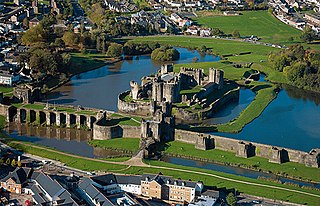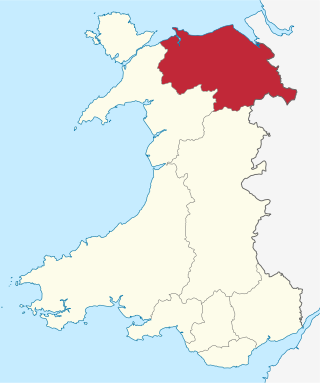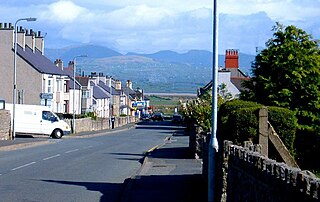
Chatham is a town located within the Medway unitary authority in the ceremonial county of Kent, England. The town forms a conurbation with neighbouring towns Gillingham, Rochester, Strood and Rainham. In 2020 it had a population of 80,596.

Haverfordwest is the county town of Pembrokeshire, Wales, and the most populous urban area in Pembrokeshire with a population of 14,596 in 2011. It is also a community, being the second most populous community in the county, with 12,042 people, after Milford Haven. The suburbs include the former parish of Prendergast, Albert Town and the residential and industrial areas of Withybush.

Caerphilly is a town and community in Wales. It is situated at the southern end of the Rhymney Valley.

Clwyd is a preserved county of Wales, situated in the north-east corner of the country; it is named after the River Clwyd, which runs through the area. To the north lies the Irish Sea, with the English ceremonial counties of Cheshire to the east and Shropshire to the south-east. Powys and Gwynedd lie to the south and west respectively. Clwyd also shares a maritime boundary with Merseyside along the River Dee. Between 1974 and 1996, a slightly different area had a county council, with local government functions shared with six district councils. In 1996, Clwyd was abolished, and the new principal areas of Conwy County Borough, Denbighshire, Flintshire and Wrexham County Borough were created; under this reorganisation, "Clwyd" became a preserved county, with the name being retained for certain ceremonial functions.

Newborough is a village in the southern corner of the Isle of Anglesey in Wales. It is a part of the Bro Aberffraw electoral ward; to the northwest is Aberffraw, and to the northeast is Llanfairpwll. There is a church in the village, and a public institute. Nearby is the Newborough Warren, a forest, beach, and public nature reserve.

Ruabon is a village and community in Wrexham County Borough, Wales. The name comes from Rhiw Fabon, rhiw being the Welsh word for "slope" or "hillside" and Fabon being a mutation from St Mabon, the original church name, of earlier, Celtic origin. An older English spelling, Rhuabon, can sometimes be seen.

Penmynydd, meaning "top of the mountain" in Welsh, is a village and community on Anglesey, Wales. It is known for being the birthplace of the Tudors of Penmynydd, which became the House of Tudor. The population according to the United Kingdom Census 2011 was 465. The community includes the village of Star and the hamlet of Castellior.

Abermenai Point is a headland in the southeast of the island of Anglesey in Wales. It is the southernmost point of the island and is the northern point of the western entrance of the Menai Strait.

Gwydir Castle is situated in the Conwy valley, Wales, a mile to the west of the ancient market town of Llanrwst and 1.5 miles (2.4 km) to the south of the large village of Trefriw. An example of a fortified manor house dating back to c. 1500, it is located on the edge of the floodplain of the river Conwy, and overlooked from the west by the now-forested slopes of Gwydir Forest.

Bodysgallen Hall is a manor house in Conwy county borough, north Wales, near the village of Llanrhos. Since 2008 the house has been owned by The National Trust. It is a Grade I listed building, currently used as a hotel. This listed historical building derives primarily from the 17th century, and has several later additions. Bodysgallen was constructed as a tower house in the Middle Ages to serve as defensive support for nearby Conwy Castle. According to tradition, the site of Bodysgallen was the 5th century AD stronghold of Cadwallon Lawhir, King of Gwynedd, who had wide-ranging exploits as far as Northumberland.

Thomas Wynn, 1st Baron Newborough, known as Sir Thomas Wynn, 3rd Baronet, from 1773 to 1776, was a British politician who sat in the House of Commons between 1761 and 1807.
Beaumaris was a parliamentary borough in Anglesey, which returned one Member of Parliament (MP) to the House of Commons of the Parliament of England from 1553, then to the Parliament of Great Britain from 1707 to 1800 and to the Parliament of the United Kingdom from 1801 to 1885, when the constituency was abolished. After 1832, the constituency was usually known as the Beaumaris District of Boroughs or simply the Beaumaris Boroughs.

Glynllifon is an old estate which belonged to the Barons Newborough, near the village of Llandwrog on the main A499 road between Pwllheli and Caernarfon in Gwynedd, Wales. The original mansion was until recently a privately owned hotel.
Robert Charles Michael Vaughan Wynn, 7th Baron Newborough, DSC was a British peer and Royal Naval Volunteer Reserve officer who played a decisive role during the St. Nazaire Raid in 1942 where he commanded a Motor Torpedo Boat. Captured after his boat had to be abandoned, he was sent to Colditz after an escape attempt. He was repatriated after feigning illness.
Sir John Wynn, 2nd Baronet, of Glynllifon and Bodvean, Caernarvonshire and Melai, Denbighshire was a Welsh politician who sat in the House of Commons between 1740 and 1768.

Castellau is a hamlet, with a country house of the same name in the county borough of Rhondda Cynon Taf, South Wales. Historically, it lies within the parish of Llantrisant, just north-west of Beddau. It is connected with the history of the Trahernes. In 1988, Ysgol Castellau became the first Welsh medium education school to open in the southeast within new buildings.

Maenan Abbey was a monastic religious house located in Maenan, Conwy, Wales. It is situated near Llanrwst.
Harristown is a townland in County Kildare on the River Liffey 2.5 miles (4.0 km) downstream from Kilcullen, just north of Brannockstown in the civil parish of Carnalway in the barony of Naas South. It is the site of a former borough and manor, and Harristown Borough was a borough constituency sending two MPs to the Irish House of Commons before the Acts of Union 1800. Harristown Common is a townland and former commonage north of Harristown proper and separated from it by the townlands of Dunnstown and Johnstown or Dunshane.

The Defensible Barracks at Pembroke Dock, is a Grade II* listed, Victorian-era fortification and barracks in Pembrokeshire, South Wales. It is a 20-sided stone fort surrounded by a dry moat with masonry walls. A parade ground occupies the centre of the fort. It was built in the mid-1840s to house the Royal Marines based in Pembroke Dockyard and to protect the dockyard.

Tynte's Castle is a tower house located in Youghal, eastern County Cork, Ireland.




















